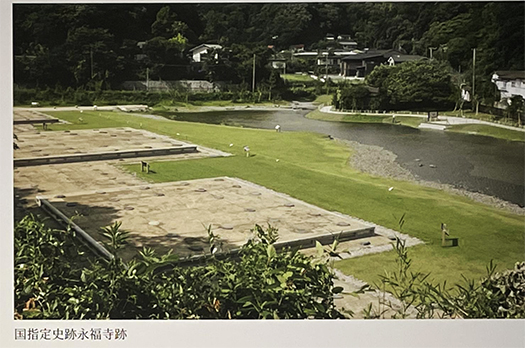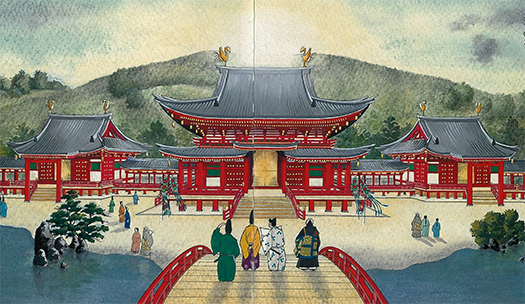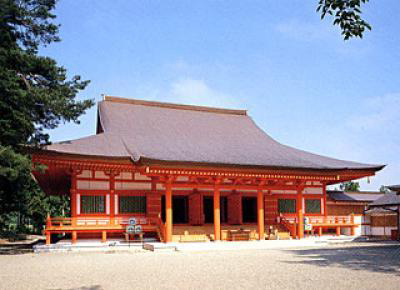


先般の鎌倉探訪シリーズで書き忘れていたテーマがいくつかあります。その中でも以前から気になっていた「永福寺」のこと。歴史事実では、1189年に奥州藤原氏を滅亡させる奥州戦争で遠征したあとに、平泉の「毛通寺」を見て頼朝は深く打たれ、鎌倉にほぼ同様の寺院建立を決めたとされる。
そこから建築計画が始動して、毛通寺によく似た寺院が作られ1333年に炎上し消失した。なので現実に存在したのは144年間にしか過ぎない。現代になって史跡として跡地が整備され、鎌倉歴史文化交流館ではVR体験できるコーナーも設けられていた。市としては再建したいと考えているのでしょう。
わたしもこのVRを体験してみましたが「毛通寺と基本的な建築思想が同じ」という実感。毛通寺は同時代の平等院鳳凰堂などの臨池式寺院建築を平泉に造営したものですが、この永福寺の建築施主・頼朝の眼中には毛通寺しかなく、その建築思想を鎌倉に移築したというのが実相とされる。
〜建久2年(1191)2月15日 頼朝、永福寺を建てる場所を決めるため、大倉周辺を探す。
建久3年(1192)1月21日 頼朝、二階堂建設現場で土工事を見る。8月27日 頼朝、庭造りの専門家、静玄を京都から招き、庭石の配置について相談する。9月11日 静玄、庭の池に石をならべ、頼朝はこの様子を見学する。10月29日 二階堂の扉と仏背後の壁画が完成する。奥州毛越寺の金堂(円隆寺)の壁画を模す。〜というような建築経緯記録を見ると頼朝の心底がうかがえる。

源平騒乱を勝ち抜いた鎌倉の武力権力として平泉の独立的地域政権に対して抱いていた心象が深く顕現していたのではないかと思っています。頼朝の心理として、平泉政権に対しての複雑な内面がこのナゾの寺院建築に凝集しているのではないか。建築としての永福寺が鎌倉幕府の滅亡と期を一にして消失していくのには、どうもそういう「因果」があるように思える。
そして現代に至って平泉の毛通寺は臨池は残り建築も写真のように一部が再建されているのに対して、永福寺はCG画像でしか残っていない。奥州藤原氏が頼朝に一矢報いているとも感じる。
年表を見ると、頼朝が征夷大将軍に任命された建久3年(1192)に中心の二階堂が完成とある。建築の発願趣旨において、奥州合戦で亡くなった弟の義経や藤原泰衡らの霊を供養するためにとあるけれど、やはり永福寺は頼朝のこころの中がそのまま建築表現されたものだったと思えますね。
こういった毛通寺と永福寺の建築遺跡の対比性というのは、建築史的にも興味深いのではないでしょうか。
English version⬇
Eifukuji, the riddle of the great Kamakura temple, and the heart’s desire of its owner, Yoritomo.
The architectural complexes such as Mōtsūji Temple symbolize the independent government of Hiraizumi. The victor, the Kamakura Shogunate, Yoritomo seemed to have a certain complex about them in his mind. …
There are several themes that I forgot to write about in my recent series on exploring Kamakura. Among them is Eifukuji Temple, which has been on my mind for some time. According to historical facts, Yoritomo was deeply struck by seeing “Motsu-ji” in Hiraizumi after his expedition in 1189 in the Oshu War that decimated the Oshu Fujiwara clan, and decided to build an almost similar temple in Kamakura.
From there, a building project was initiated, and a temple similar to Motsu-dera was built, but it was destroyed by fire in 1333. Therefore, the temple existed for only 144 years in reality. In modern times, the site has been developed as a historical site, and a VR experience corner was set up at the Kamakura History and Culture Exchange Center. The city probably wants to rebuild it.
I also experienced this VR and felt that “the basic architectural concept is the same as that of Mōtsūji Temple. The Motsu-ji was built in Hiraizumi in the same period as the Byodoin Phoenix Hall and other Rin-ike style temples, but Yoritomo, the owner of Eifuku-ji, had only Motsu-ji in his mind, and it is said that he transferred the architectural concept of Motsu-ji to Kamakura.
〜On February 15, 1191, Yoritomo searched the area around Okura to decide where to build Eifukuji Temple.
January 21, 1192: Yoritomo observes earthwork at the site of the Nikaidō construction site; August 27: Yoritomo invites Shizugen, an expert in garden design, from Kyoto to consult on the placement of garden stones; September 11: Shizugen arranges stones in the garden pond, which Yoritomo observes; October 29: The door to the Nikaidō and the mural paintings behind the Buddha are completed. The murals were modeled after those in the Kondo (Enryu-ji Temple) of Motsu-ji in Oshu. 〜The record of the building’s history shows Yoritomo’s deepest feelings.
I believe that this temple may have been a deep manifestation of the image that Yoritomo had of the independent regional government of Hiraizumi as the armed power of Kamakura that had survived the Genpei uprising. Yoritomo’s complex inner feelings toward the Hiraizumi regime may have coalesced in the architecture of this mysterious temple. The disappearance of Eifukuji as an architectural structure coinciding with the downfall of the Kamakura Shogunate seems to have such a “cause and effect.
In the present day, Mōtsū-ji in Hiraizumi has been partially reconstructed, as shown in the photo, while Eifuku-ji remains only as a computer-generated image. It seems as if the Oshu Fujiwara clan was taking a shot at Yoritomo.
According to the chronology, the central Nikaido hall was completed in 1192, the year Yoritomo was appointed barbarian general. The purpose of the temple’s construction was to offer memorial services to the spirits of his younger brothers Yoshitsune and Fujiwara Yasuhira, who died in the Battle of Oshu, but it seems that Eifukuji Temple was an architectural expression of the spirit of Yoritomo.
The contrast between the architectural remains of Mōtsūji and Eifukuji is interesting from an architectural historical perspective.
Posted on 4月 18th, 2023 by 三木 奎吾
Filed under: 歴史探訪







コメントを投稿
「※誹謗中傷や、悪意のある書き込み、営利目的などのコメントを防ぐために、投稿された全てのコメントは一時的に保留されますのでご了承ください。」
You must be logged in to post a comment.